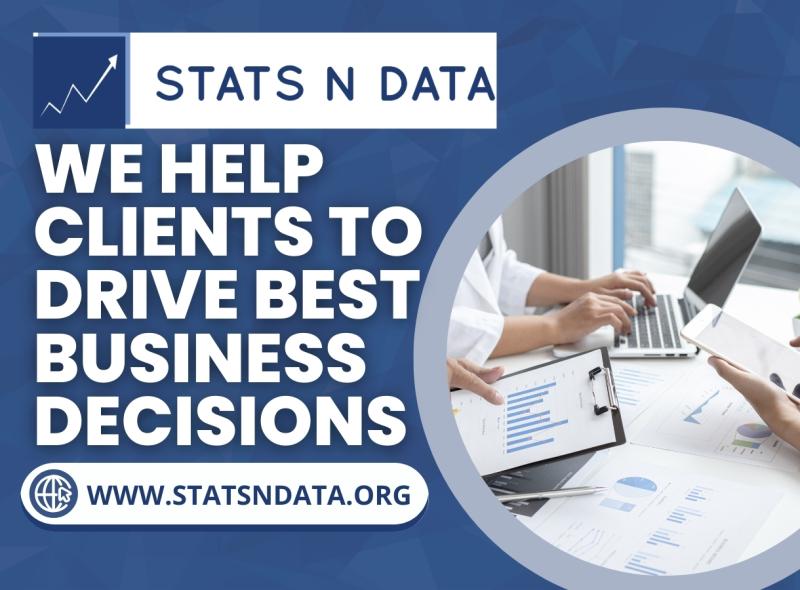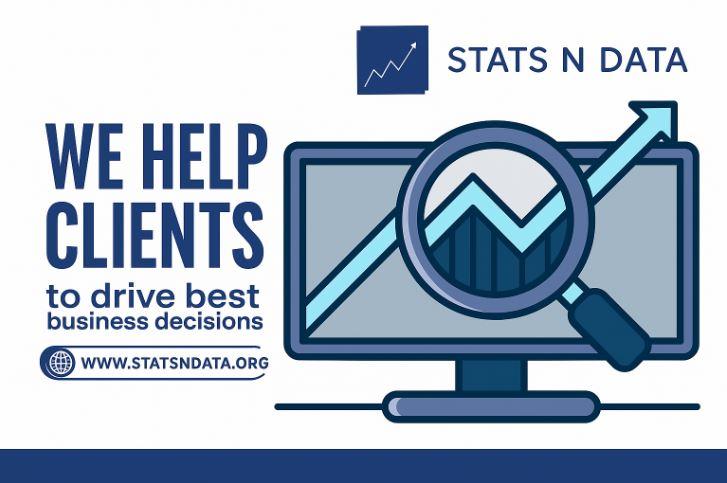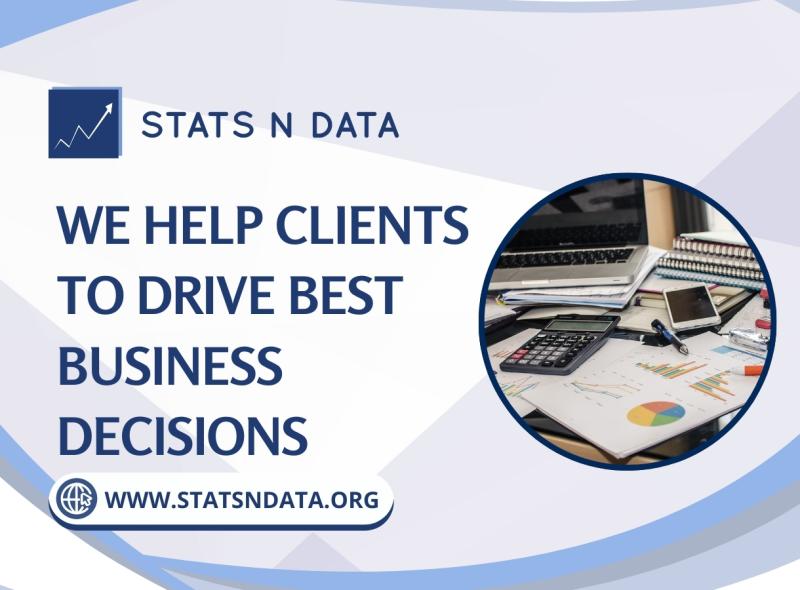Press release
AI in Military Market 12.60% CAGR Growth with BAE Systems Raytheon L3Harris Northrop Grumman Leidos Lockheed Martin General Dynamics Thales
The integration of artificial intelligence (AI) into military operations is transforming defense strategies and capabilities across the globe. The military AI market is expected to experience significant growth, with a projected compound annual growth rate (CAGR) of 12.60% from 2025 to 2032. This expansion is driven by the increasing demand for advanced technologies that enhance decision-making processes, improve operational efficiency, and optimize resource allocation. As nations recognize the strategic advantages offered by AI, investments in AI-driven systems are becoming a critical component of military modernization initiatives.You can access a sample PDF report here: https://www.statsndata.org/download-sample.php?id=153556
AI applications in the military sector encompass various domains, including autonomous systems, data analysis, cybersecurity, and logistics management. The development of autonomous vehicles and drones, for instance, is reshaping how military operations are conducted, enabling forces to carry out missions with greater precision and reduced risk to personnel. Furthermore, AI's ability to process vast amounts of data in real time enhances situational awareness and enables commanders to make informed decisions quickly. As threats evolve and become more complex, the military's reliance on sophisticated AI tools is expected to increase, ensuring that armed forces remain agile and effective in dynamic environments.
With the ongoing advancements in machine learning and AI technologies, the military AI market is poised for substantial growth, with expectations to surpass an approximate valuation of USD 30 billion by 2032. This growth trajectory reflects the military's commitment to adopting innovative technologies that not only bolster national security but also enhance collaboration and interoperability among allied forces. As countries continue to prioritize defense spending, particularly in the realm of AI, the landscape of military operations is set to be significantly transformed, paving the way for a new era of warfare that leverages cutting-edge technology.
The AI in Military market is undergoing a significant transformation, driven by advancements in technology and an evolving understanding of artificial intelligence applications within defense environments. With the integration of military artificial intelligence, defense technology AI, and military robotics, the sector is poised for substantial growth. Autonomous weapons, AI warfare, and intelligent defense systems represent just a few of the ways AI is impacting military operations globally. As defense agencies and contractors continue to adopt AI-driven solutions, the market is expected to expand, offering valuable insights for executives, investors, and decision-makers.
Market Overview and Recent Developments
The AI in Military market encompasses a wide range of applications, including military drones, AI surveillance systems, and combat AI. This market is characterized by a growing reliance on technology to enhance operational efficiency, decision-making capabilities, and overall mission success. Recent breakthroughs in AI research and development, coupled with strategic partnerships among industry leaders, have catalyzed market growth. Organizations are increasingly leveraging AI to improve military logistics, enhance soldier capabilities, and enable AI-driven decision making in combat situations.
As defense budgets increase and nations prioritize modernization, AI is emerging as a key component of future military technology. The rise of AI in military operations has sparked interest not only in defense applications but also in areas such as military intelligence analysis and cybersecurity in defense. The integration of AI into military training programs is reshaping how armed forces prepare for modern warfare, ensuring that personnel are equipped with the skills necessary to navigate complex environments.
Key Growth Drivers and Trends
Several key factors are driving the growth of AI in the military sector. Sustainability is increasingly becoming a priority, as defense organizations seek to minimize their environmental impact while improving operational effectiveness. Digitization is transforming how militaries operate, enabling real-time data processing and analysis, which is critical for strategic military planning.
Shifting consumer expectations are also influencing the adoption of AI technologies within the military. The demand for personalized and customized solutions is leading to the development of innovative products that cater to specific operational needs. The integration of AI into existing systems is not only enhancing capabilities but also supporting the development of new technologies that redefine military operations.
Transformative trends such as the use of AI for military decision-making, logistics, and combat simulation are reshaping the landscape. As defense forces adopt more sophisticated AI applications, the impact of artificial intelligence on warfare becomes increasingly evident. The collaboration of AI and human soldiers is paving the way for enhanced operational effectiveness and strategic advantages.
Market Segmentation
The AI in Military market can be segmented in various ways, providing a comprehensive understanding of its structure. The key segments include:
Segment by Type
- Hardware
- Software
- Service
Segment by Application
- Warfare Platform
- Cyber Security
- Logistics and Transportation
- Combat Simulation and Training
- Command and Control
- Information Processing
- Others
This detailed segmentation allows stakeholders to identify opportunities for investment and innovation, ensuring that they remain competitive in a rapidly evolving landscape.
Competitive Landscape
The competitive landscape of the AI in Military market is characterized by the presence of several leading players. Each company is making significant strides in the development and deployment of AI technologies:
- BAE Systems: Focused on integrating AI for enhanced decision-making processes, BAE Systems is developing intelligent defense systems that support real-time situational awareness.
- Raytheon: Raytheon is leveraging AI to improve military communications and surveillance systems, enhancing the capabilities of military drones and operational platforms.
- L3Harris: L3Harris is advancing AI-driven cyber security solutions to protect defense networks from emerging threats, ensuring mission-critical operations remain secure.
- Northrop Grumman: Northrop Grumman is exploring AI applications in unmanned systems, focusing on autonomous weapons and advanced military robotics.
- Leidos: Leidos is pioneering AI in logistics and transportation, streamlining supply chain management and operational efficiencies for military organizations.
- Lockheed Martin: Lockheed Martin is developing next-generation AI warfare systems that integrate seamlessly with existing military platforms, enhancing overall operational effectiveness.
- General Dynamics: Committed to AI for combat simulation and training, General Dynamics is providing innovative solutions that improve the preparedness of military personnel.
- Thales: Thales is utilizing AI for information processing and command and control systems, fostering enhanced situational awareness in military operations.
- IBM: Through its AI and data analytics capabilities, IBM is revolutionizing military intelligence analysis, enabling more informed decision-making processes.
- Rafael: Rafael is focused on AI-driven military drone technology, enhancing surveillance and reconnaissance capabilities for armed forces.
- Nvidia: Nvidia is at the forefront of AI-powered military simulations, providing high-performance computing solutions for combat training environments.
- SparkCognition: SparkCognition is developing AI-driven cybersecurity solutions tailored for defense applications, protecting critical infrastructure from cyber threats.
- Charles River Analytics: Specializing in AI applications for military training programs, Charles River Analytics is enhancing the effectiveness of training simulations.
- C3 AI: C3 AI is providing platforms for AI-driven decision making in combat situations, enabling faster and more accurate tactical responses.
- Changsha Jingjia Microelectronics: This company is focusing on AI hardware development, specifically for military robotics and autonomous applications.
Opportunities and Challenges
The AI in Military market presents a wealth of opportunities, particularly in untapped niches and evolving buyer personas. As defense budgets expand, there is a growing demand for innovative solutions that leverage AI and enhance military capabilities. Monetization avenues such as AI logistics in military and military decision-making AI are critical for sustained growth.
However, challenges remain. Regulatory hurdles can impede the rapid adoption of AI technologies in defense, and supply chain gaps may disrupt the availability of essential components. To navigate these challenges, stakeholders must engage in proactive collaboration with regulatory bodies and invest in resilient supply chain strategies.
Technological Advancements
Cutting-edge tools such as AI, digital twins, IoT, virtual reality, and blockchain are transforming the AI in Military market. AI is revolutionizing the analysis of vast datasets, enabling commanders to make informed decisions rapidly. Digital twins are enhancing simulation and training processes, allowing for realistic training scenarios that prepare personnel for real-world challenges. IoT devices are improving connectivity and situational awareness, while virtual reality is reshaping training programs by providing immersive environments. Blockchain technology is enhancing security and transparency in military logistics and data management.
Research Methodology and Insights
At STATS N DATA, we employ a robust research methodology to deliver reliable insights into the AI in Military market. Our top-down and bottom-up approaches ensure comprehensive data collection, while primary and secondary research methods provide a holistic view of market dynamics. Through multi-layer triangulation, we validate our findings, ensuring that our insights are accurate and actionable.
As the AI in Military market continues to evolve, STATS N DATA remains committed to providing thought leadership and valuable insights for stakeholders. Our dedication to understanding the complexities of this market positions us as a trusted authority, enabling organizations to navigate the challenges and opportunities presented by AI in military operations.
The AI in Military market is on the cusp of a transformative era, driven by technological advancements and strategic collaborations. As military organizations increasingly adopt AI technologies, the impact on warfare, logistics, and decision-making will be profound. Stakeholders must stay informed and agile to capitalize on the opportunities presented by this dynamic market. STATS N DATA is poised to lead the conversation, providing the insights and expertise necessary for success in this rapidly evolving landscape.
Get 30% Discount On Full Report: https://www.statsndata.org/ask-for-discount.php?id=153556
In the rapidly evolving landscape of modern warfare, military organizations face unprecedented challenges that demand innovative solutions. One key player in the defense sector found itself grappling with the complexities of real-time battlefield data. With vast amounts of information streaming from drones, satellites, and ground troops, the task of processing and analyzing this data to make timely, strategic decisions became increasingly daunting. The sheer volume of intelligence was overwhelming, and traditional methods of analysis were proving insufficient. Commanders often struggled to discern actionable insights amid the noise of irrelevant data, leading to delayed responses and missed opportunities on the battlefield. Recognizing the urgency of the situation, this military organization sought a transformative approach to harness the potential of artificial intelligence, aiming to turn the tide in their favor.
In a bid to address these challenges, the organization engaged in a comprehensive analysis of their data streams through advanced analytics. By utilizing cutting-edge artificial intelligence techniques, they developed a groundbreaking strategy that revolutionized their operational capabilities. The analysis focused on integrating machine learning algorithms that could sift through and categorize vast amounts of incoming data in real time. This approach allowed for the identification of critical patterns and trends that would have otherwise gone unnoticed. The framework was designed not just to process data but to learn from it, continually improving its predictive capabilities. As a result, commanders received timely insights that enabled them to make informed decisions, react swiftly to emerging threats, and allocate resources more effectively. The military organization transformed its data from a burden into a powerful asset, effectively enhancing their strategic positioning on the battlefield.
The measurable benefits of this innovative strategy were profound. Following the implementation of the advanced AI-driven analytics, the organization experienced a significant increase in market share, establishing itself as a leader in military intelligence solutions. The efficiency of operations improved dramatically, with decision-making time reduced by over 50 percent. This surge in operational efficiency translated directly into enhanced revenue streams; the organization not only retained existing contracts but also attracted new partnerships and projects that capitalized on their advanced capabilities. By turning data into actionable intelligence, the military organization achieved a level of operational readiness that had a direct impact on mission success. The integration of AI into their strategy not only reinforced their competitive edge but also set a new standard in the military sector, demonstrating how technology can be harnessed to meet the challenges of modern warfare head-on.
For customization requests, please visit: https://www.statsndata.org/request-customization.php?id=153556
Q: What is AI's role in modern military operations?
A: AI plays a transformative role in modern military operations by enhancing capabilities across various domains such as ground, air, and sea. It aids in data analysis, decision-making, and operational efficiency. AI systems can process vast amounts of data from sensors, satellites, and intelligence reports, allowing military leaders to make informed decisions quickly. AI technologies like machine learning and natural language processing enable predictive analytics, which can anticipate enemy actions or identify emerging threats. Furthermore, AI powers autonomous systems, including drones and ground robots, which can carry out missions with minimal human intervention. Overall, AI enhances situational awareness, increases operational effectiveness, and supports strategic planning.
Q: How is artificial intelligence changing warfare?
A: Artificial intelligence is changing warfare by introducing new methods of engagement and altering traditional combat dynamics. The integration of AI into military systems allows for faster decision-making, real-time data processing, and improved targeting accuracy. AI can analyze battlefield conditions and provide commanders with actionable insights, leading to more effective strategies. Additionally, AI-driven autonomous systems, such as unmanned aerial vehicles (UAVs) and self-driving vehicles, are changing how operations are conducted, reducing the risk to human soldiers. AI is also being used in cyber warfare, enhancing capabilities to detect and respond to cyber threats. Overall, AI is reshaping the landscape of warfare, making it more data-driven and technology-focused.
Q: What are the benefits of using AI in the military?
A: The benefits of using AI in the military are numerous. Firstly, AI enhances operational efficiency by automating routine tasks, allowing personnel to focus on more complex decision-making. Secondly, it improves situational awareness through advanced data analysis, helping to identify threats and opportunities more effectively. Thirdly, AI increases the speed of decision-making, which is crucial in combat scenarios where time is of the essence. Additionally, AI can optimize logistics, ensuring that supplies and reinforcements are delivered where they are needed most. Finally, AI can enhance training through simulations and virtual environments, preparing soldiers for a variety of scenarios they may face in the field. Overall, the integration of AI contributes to a more agile and responsive military force.
Q: What challenges does the military face with AI implementation?
A: The military faces several challenges with AI implementation, including technological, ethical, and operational hurdles. One major challenge is the integration of AI systems with existing military infrastructure, which can be complex and costly. There is also the challenge of ensuring data quality and security, as AI systems rely on large amounts of data to function effectively. Ethical concerns arise regarding the autonomy of AI systems, particularly in lethal scenarios, leading to debates about accountability and decision-making in combat. Furthermore, there is the risk of adversaries leveraging AI technologies, which could escalate arms races and lead to new forms of warfare. Training personnel to work effectively with AI systems is another significant challenge, as it requires new skill sets and knowledge.
Q: How do military drones utilize AI technology?
A: Military drones utilize AI technology in various ways, enhancing their capabilities and effectiveness in combat and reconnaissance missions. AI enables drones to process sensor data in real-time, allowing them to navigate complex environments autonomously. This includes avoiding obstacles, identifying targets, and executing missions with minimal human oversight. AI algorithms can analyze video feeds from drones to detect enemy movements or assess damage after an attack. Additionally, drones equipped with AI can perform predictive analytics to anticipate potential threats, allowing for proactive measures. Overall, AI significantly enhances the operational capabilities of military drones, making them more versatile and effective in various missions.
Q: What ethical concerns arise from AI in warfare?
A: The use of AI in warfare raises several ethical concerns that are the subject of ongoing debate. One primary concern is the issue of autonomy in lethal systems, where AI may make life-and-death decisions without human intervention. This raises questions about accountability and moral responsibility in the event of unintended consequences or civilian casualties. Another ethical concern is the potential for AI to be used in ways that violate international humanitarian law, such as targeting non-combatants or engaging in indiscriminate attacks. The opacity of AI decision-making processes can also lead to a lack of transparency, making it difficult to hold parties accountable for their actions. Furthermore, there are concerns about the arms race in AI technologies, which could lead to destabilization and increased violence. These ethical challenges necessitate careful consideration and regulation as AI technologies continue to evolve in military contexts.
Q: How can AI improve military logistics?
A: AI can significantly improve military logistics through enhanced efficiency, predictive analysis, and real-time decision-making. By analyzing data on supply chains, troop movements, and equipment availability, AI can optimize the allocation of resources and predict logistical needs. This includes determining the most efficient routes for transportation and anticipating maintenance requirements for vehicles and equipment. AI systems can also monitor inventory levels and predict shortages, ensuring that supplies are available when needed. Additionally, AI can facilitate better coordination among different branches of the military, improving overall operational readiness. By streamlining logistics, AI helps reduce costs and enhances the effectiveness of military operations.
Q: What is the future of AI in defense technology?
A: The future of AI in defense technology is likely to be characterized by rapid advancements and increased integration across military operations. As AI technologies continue to develop, we can expect to see more sophisticated systems that enhance decision-making, improve targeting accuracy, and automate various military functions. The use of AI in cyber defense will also grow, with systems designed to detect and neutralize cyber threats in real-time. Furthermore, the trend toward autonomous systems, including both ground and aerial vehicles, will continue to reshape military strategies and operations. However, this future will also require ongoing discussions about ethical considerations, governance, and international regulations regarding the use of AI in warfare. As nations invest in AI for defense, it will be crucial to balance technological advancements with responsible use.
Q: How does AI influence military decision-making?
A: AI influences military decision-making by providing commanders with data-driven insights and predictive analytics. By processing vast amounts of information from various sources, AI can identify patterns, assess risks, and forecast potential scenarios. This allows military leaders to make informed decisions more quickly than traditional methods would permit. AI systems can also simulate different courses of action, helping commanders evaluate the potential outcomes of their decisions before executing them. Additionally, AI can assist in optimizing resource allocation and logistics, ensuring that decisions are based on real-time data. Overall, AI enhances the decision-making process by increasing situational awareness and providing actionable intelligence.
Q: In what ways are soldiers enhanced by AI?
A: Soldiers are enhanced by AI in several ways that improve their effectiveness and safety in the field. AI-powered systems can assist soldiers with real-time information, such as battlefield conditions and enemy locations, enabling them to make better tactical decisions. Wearable AI technologies can monitor soldiers' health and stress levels, providing feedback that can help manage fatigue and enhance performance. AI can also be integrated into training programs, using virtual simulations to prepare soldiers for various scenarios they may encounter. Furthermore, AI-driven robotic systems can assist soldiers in dangerous tasks, such as bomb disposal or reconnaissance missions, reducing the risk to human life. Overall, AI enhances the capabilities of soldiers, making them more efficient and effective in their roles.
Q: What are the applications of AI in military training?
A: AI has numerous applications in military training, enhancing the way soldiers prepare for combat and other scenarios. One significant application is the use of AI-driven simulations, which allow soldiers to practice decision-making and tactical maneuvers in virtual environments that mimic real-world conditions. These simulations can adapt to the actions of the trainees, providing a dynamic and challenging training experience. AI can also analyze trainees' performance, offering personalized feedback and identifying areas for improvement. Additionally, AI can facilitate collaborative training exercises across different units, improving coordination and teamwork. Finally, AI can help develop training programs that are more efficient and effective, focusing on the skills and knowledge that soldiers need most. Overall, AI is transforming military training by making it more immersive, adaptive, and data-driven.
Q: How does AI help in military intelligence?
A: AI helps military intelligence by automating data analysis, improving threat detection, and enhancing situational awareness. AI algorithms can sift through vast amounts of data from various sources, such as satellite imagery, social media, and intercepted communications, to identify patterns and potential threats. This capability allows intelligence analysts to focus on higher-level analysis instead of spending time on data processing. AI can also support predictive analytics, helping to forecast enemy movements or intentions based on historical data. Furthermore, AI can enhance geospatial intelligence by analyzing imagery from drones or satellites to detect changes in terrain or activity. Overall, AI significantly improves the efficiency and accuracy of military intelligence operations.
Q: What impact does AI have on combat strategies?
A: AI impacts combat strategies by enabling more data-driven and flexible approaches to warfare. With AI, military commanders can analyze real-time data from the battlefield, allowing them to adapt strategies quickly based on changing conditions. AI can enhance target identification and selection, improving the precision of strikes and reducing collateral damage. The use of AI in simulations also allows military planners to test various strategies and outcomes before engaging in actual combat, leading to more informed decision-making. Additionally, AI can facilitate decentralized command structures, where autonomous systems operate independently while still aligning with overall mission objectives. This allows for more dynamic and responsive combat strategies that can adapt to the complexities of modern warfare.
Q: How is AI used in surveillance for defense?
A: AI is used in surveillance for defense by automating the analysis of data collected from various sensors, including cameras, drones, and satellites. AI systems can process video feeds in real-time, identifying and tracking objects of interest, such as enemy personnel or vehicles. This capability enhances situational awareness and allows military forces to respond quickly to emerging threats. AI can also analyze historical surveillance data to detect patterns or anomalies that may indicate potential risks. Furthermore, AI-powered surveillance systems can operate autonomously, conducting reconnaissance missions without direct human oversight. Overall, AI significantly improves the effectiveness and efficiency of military surveillance operations, providing commanders with timely and actionable intelligence.
Q: What are the risks associated with AI in military operations?
A: The risks associated with AI in military operations are multifaceted and warrant careful consideration. One significant risk is the potential for unintended consequences, such as misidentifying targets or executing actions that lead to civilian casualties. This is particularly concerning in autonomous systems that make decisions without human intervention. Additionally, AI systems can be vulnerable to hacking or manipulation, which could compromise military operations and intelligence. There is also the risk of over-reliance on AI, where decision-makers may defer to automated systems without critical human oversight, potentially leading to flawed judgments. Furthermore, the rapid pace of AI development means that military strategies may lag behind technological advancements, creating vulnerabilities in operations. Finally, the use of AI in warfare raises ethical questions and could lead to an arms race in autonomous weapons, increasing global instability. As such, it is essential for military organizations to establish guidelines and frameworks to mitigate these risks effectively.
Related Reports
Digital Printed Cartons Market
https://www.statsndata.org/report/digital-printed-cartons-market-11877
Textile Care Chemicals Market
https://www.statsndata.org/report/textile-care-chemicals-market-331678
High Power Fiber Laser Chip Market
https://www.statsndata.org/report/high-power-fiber-laser-chip-market-129220
Corrosion Resistant Resin Market
https://www.statsndata.org/report/corrosion-resistant-resin-market-322215
Reversible Thermochromic Film Market
https://www.statsndata.org/report/reversible-thermochromic-film-market-140524
John Jones
Sales & Marketing Head | Stats N Data
Email: sales@statsndata.org
Website: www.statsndata.org
STATS N DATA is a trusted provider of industry intelligence and market research, delivering actionable insights to businesses across diverse sectors. We specialize in helping organizations navigate complex markets with advanced analytics, detailed market segmentation, and strategic guidance. Our expertise spans industries including technology, healthcare, telecommunications, energy, food & beverages, and more.
Committed to accuracy and innovation, we provide tailored reports that empower clients to make informed decisions, identify emerging opportunities, and achieve sustainable growth. Our team of skilled analysts leverages cutting-edge methodologies to ensure every report addresses the unique challenges of our clients.
At STATS N DATA, we transform data into knowledge and insights into success. Partner with us to gain a competitive edge in today's fast-paced business environment. For more information, visit https://www.statsndata.org or contact us today at sales@statsndata.org
This release was published on openPR.
Permanent link to this press release:
Copy
Please set a link in the press area of your homepage to this press release on openPR. openPR disclaims liability for any content contained in this release.
You can edit or delete your press release AI in Military Market 12.60% CAGR Growth with BAE Systems Raytheon L3Harris Northrop Grumman Leidos Lockheed Martin General Dynamics Thales here
News-ID: 4188613 • Views: …
More Releases from STATS N DATA

Nitro-Infused Tea Market Sees 11.20% Surge with Starbucks, Rise Brewing, Novus T …
The Nitro-Infused Tea market is experiencing a notable surge in popularity, driven by the growing consumer demand for innovative beverage options that deliver unique taste experiences and enhanced refreshment. Nitro-infused teas, which involve infusing traditional tea with nitrogen to create a creamy texture and frothy head, are becoming increasingly appealing to health-conscious consumers. This innovative approach not only enhances the flavor profile of tea but also provides a refreshing alternative…

Ultra-thin Flexible PCB Market 11.20% CAGR Growth with Rocket PCB Compass Techno …
The ultra-thin flexible printed circuit board (PCB) market is experiencing significant growth, driven by advancements in technology and increasing demand across various industries. These ultra-thin flexible PCBs offer substantial advantages, including lightweight design, high flexibility, and improved space efficiency, making them ideal for applications in consumer electronics, healthcare devices, automotive systems, and wearable technology. As manufacturers strive for miniaturization and enhanced performance, the adoption of ultra-thin flexible PCBs is expected…

Lipidomics Services Market 11.20% CAGR Growth with BGI Genomics Lipotype Metabol …
The lipidomics services market is experiencing significant growth, driven by advancements in analytical techniques and an increasing understanding of the role of lipids in various biological processes. Lipidomics, the comprehensive study of lipids within biological systems, is becoming increasingly important in fields such as drug development, disease diagnosis, and personalized medicine. As researchers continue to uncover the complexities of lipid metabolism and its implications for health and disease, the demand…

Durable Polyimide Aerogel Market 11.20% CAGR Growth with Blueshift Materials Jia …
The durable polyimide aerogel market is poised for significant growth, driven by the increasing demand for lightweight and high-performance materials across various industries. As a highly efficient thermal insulator, polyimide aerogel is gaining traction in sectors such as aerospace, automotive, electronics, and construction. Its unique properties, including low thermal conductivity, high thermal stability, and excellent mechanical strength, make it an ideal choice for applications where weight reduction and thermal management…
More Releases for Military
Growing Military Spending Propels Military Actuators Market: A Significant Drive …
The Military Actuators Market Report by The Business Research Company delivers a detailed market assessment, covering size projections from 2025 to 2034. This report explores crucial market trends, major drivers and market segmentation by [key segment categories].
What Is the Military Actuators Market Size and Projected Growth Rate?
The Military Actuators Market Report by The Business Research Company delivers a detailed market assessment, covering size projections from 2025 to 2034. This report…
Military Exoskeleton Market Projected to Show Strong Growth Global Military Exos …
Advance Market Analytics published a new research publication on "Military Exoskeleton Market Insights, to 2028" with 232 pages and enriched with self-explained Tables and charts in presentable format. In the Study you will find new evolving Trends, Drivers, Restraints, Opportunities generated by targeting market associated stakeholders. The growth of the Military Exoskeleton market was mainly driven by the increasing R&D spending across the world.
Get Free Exclusive PDF Sample Copy of…
Military Satellite Market Size, Military Satellite Market Forecast, Military Sat …
According to The Insight Partners, "Military Satellite Market" report 2028, discusses various factors driving or restraining the market, which will help the future market to grow with promising CAGR. The Military Satellite Market Research Reports offers an extensive collection of reports on different markets covering crucial details. The report studies the competitive environment of the Military Satellite Market is based on company profiles and their efforts on increasing product value…
Global Military Helicopters Market 2018, Military Helicopters Market Growth, Mil …
The latest trending report Global Military Helicopters Market 2018 by Manufacturers, Regions, Type and Application, Forecast to 2023 offered by Fior Markets is an informative study covering the market with detailed analysis. This is one of the most promising and extremely categorized sectors. The research report assesses historical, latest values, and current changes to forecast market way for upcoming years from 2018 to 2023. The report evaluates various aspects of…
Global Military Tents Market 2018 Introduction by Type - Metal Stent Military Te …
Military Tents Market Overview
Reports Monitor’s latest market research report on the Global Military Tents Market provides a comprehensive analysis of some of the most significant trends and patterns that are anticipated to impact the market potentials throughout the forecast period. Reports Monitor defines an emerging trend as a leading factor that has the latent to strike the market and bestow to its growth or decline.
The report considers the current market trends and inclinations,…
Military Communications Market Report 2018: Segmentation by Communication Type ( …
Global Military Communications market research report provides company profile for Aselsan (Turkey), BAE Systems (UK), Cobham (UK), Elbit Systems (Israel), General Dynamics (US), Harris Corporation (US), Inmarsat (UK), Iridium Communications (US), Israel Aerospace Industries (Israel), Kongsberg (Norway), L3 Technologies (US), Leonardo (Italy), Lockheed Martin (US), Northrop Grumman (US) and Others.
This market study includes data about consumer perspective, comprehensive analysis, statistics, market share, company performances (Stocks), historical analysis 2012 to…
